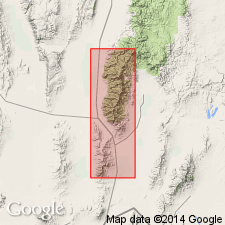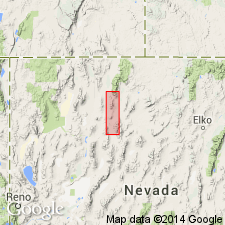
- Usage in publication:
-
- O'Neill formation
- Modifications:
-
- Named
- Dominant lithology:
-
- Quartzite
- AAPG geologic province:
-
- Great Basin province
Summary:
Pg. 1387, pl. 1 (geol. map). O'Neill formation. In southeast part of Santa Rosa Range, consists of about 2,000 feet of interbedded dark quartzites and phyllites. Characteristic rock is black or dark-gray, brown-weathering micaceous quartzite that forms bed 1 to 6 feet thick; this quartzite is less abundant than the phyllites and thin-bedded quartzites, but it crops out much more prominently. Folds show metamorphic cleavage helpful in identifying formation. Conformably overlies Winnemucca formation, contact drawn at top of highest calcareous slate or phyllite in dominantly calcareous and thin-bedded sequence that characterizes Winnemucca. Underlies Singas formation (new). Age is Late Triassic. Report includes geologic map with sections.
Type area: ridge between Wash O'Neill Creek and Provo Canyon, Santa Rosa Range, Winnemucca region, north-central NV. [Named from O'Neill Creek.]
Source: US geologic names lexicon (USGS Bull. 1200, p. 2829); supplemental information from GNU records (USGS DDS-6; Menlo GNULEX).

- Usage in publication:
-
- O'Neill Formation*
- Modifications:
-
- Revised
- AAPG geologic province:
-
- Great Basin province
Summary:
O'Neill Formation. Assigned to Auld Lang Syne Group (new). Type area of Compton (1960) here redesignated as type locality. Underlies Singas Formation and overlies Winnemucca Formation, both of Auld Lang Syne Group. Age is Late Triassic (Norian).
Type locality: in secs. 26 and 35, T. 41 N., R. 38 E., Paradise Valley 15-min quadrangle, south Santa Rosa Range, Humboldt Co., NV.
Source: Modified from GNU records (USGS DDS-6; Menlo GNULEX).
For more information, please contact Nancy Stamm, Geologic Names Committee Secretary.
Asterisk (*) indicates published by U.S. Geological Survey authors.
"No current usage" (†) implies that a name has been abandoned or has fallen into disuse. Former usage and, if known, replacement name given in parentheses ( ).
Slash (/) indicates name conflicts with nomenclatural guidelines (CSN, 1933; ACSN, 1961, 1970; NACSN, 1983, 2005, 2021). May be explained within brackets ([ ]).

